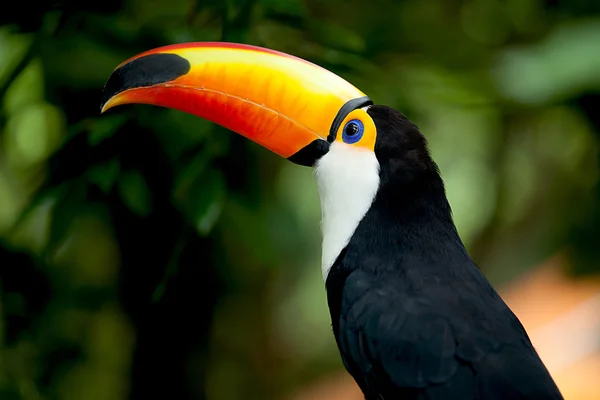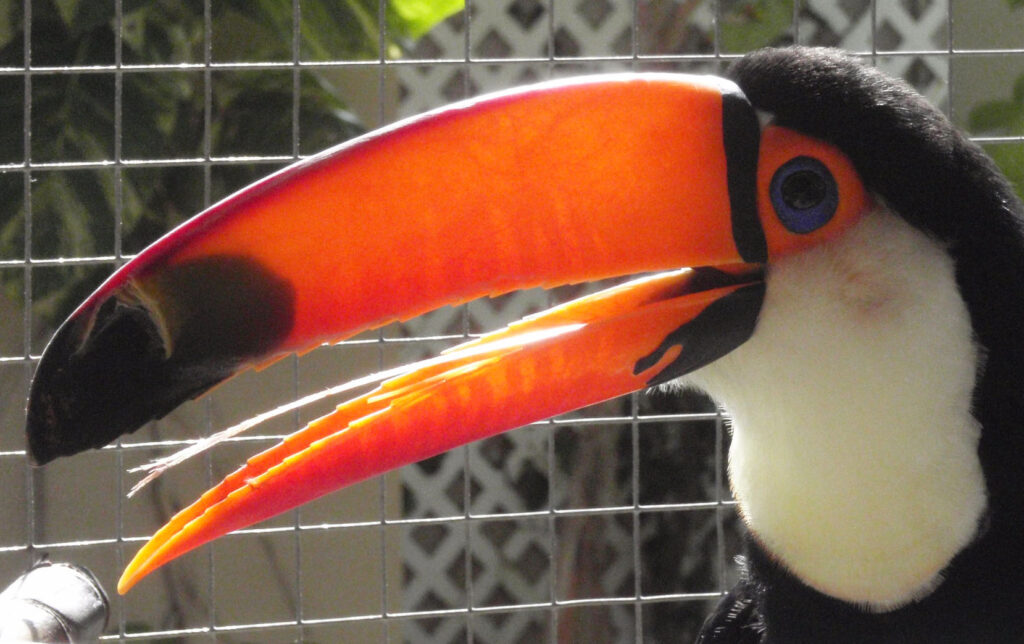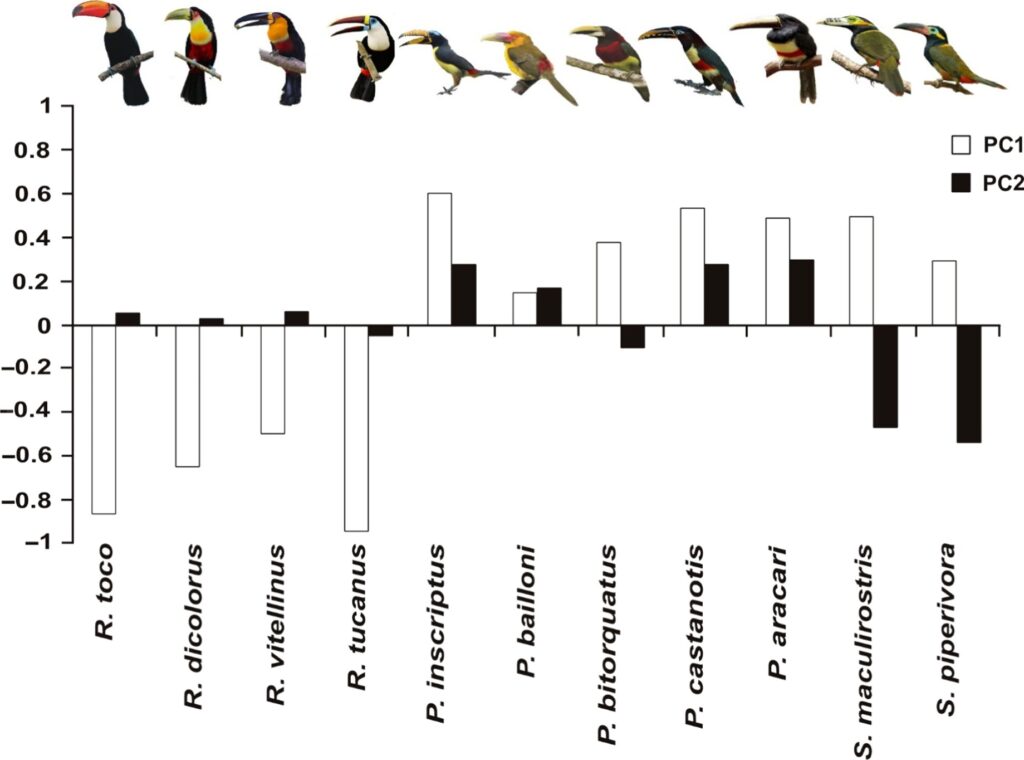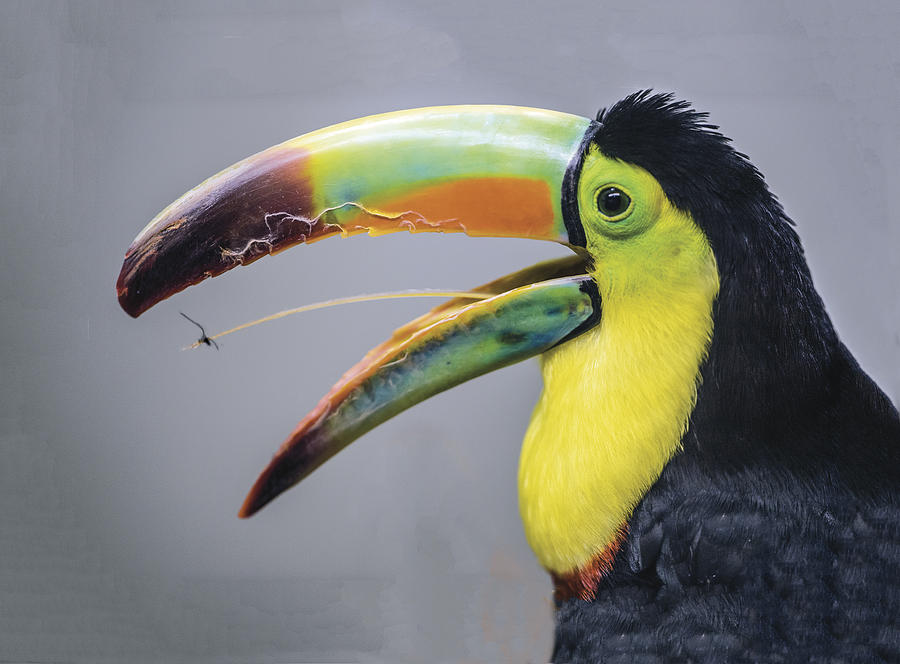Do toucans have tongues? This is a question that many people have asked themselves, but the answer is that they do not. The reason why this is so is due to the fact that toucans are birds, and birds do not have tongues.
Toucans are found in Central and South America and they are part of the Ramphastidae family. They are large birds with very colorful markings on their bodies and heads. Their beaks are long and curved, which helps them get into their food easily. They eat mostly fruit, but they also eat insects as well as small animals like mice when they can find them. They are not picky eaters, so if there is food available for them to eat, then they will eat it – regardless of what it is.
The reason why these birds do not have tongues is because they are related to other types of birds that do not have them either. For example, parrots have tongues and can use them for talking as well as eating their food; however, some types of parrots do not have this ability because their beaks were cut off by humans when they were young so that they could be domesticated easier (and sold).
The toucan is a species of bird with a very long bill. The bill can be 20% of the length of the body and is used for eating fruit, insects and nectar. Toucans use their tongues to help push food down their throat, so they do not need one.
Toucans have two types of bills. The upper bill is called a rostrum and the lower bill is called a rhamphotheca. The rostrum is completely separate from the rhamphotheca and cannot move or change shape. It is also made up of keratin which is a hard substance found in human nails, horns and hooves.
Can a toucan regrow its tongue?
The toucan is a colorful bird that has a big beak. The toucan’s tongue is so long that it can wrap around the top of its head, which makes it look like a toucan is wearing a top hat.
The toucan’s tongue is used for catching food and bringing it back to its mouth. The toucan uses its colorful feathers to attract mates and show off to other birds.
Can a toucan regrow its tongue?
Toucans have very sharp beaks that help them catch food and defend themselves against predators. Toucans also have small talons on their feet, which they use to grasp leaves when they are eating or sleeping in trees.
Toucans eat fruit and insects, but they also eat lizards, snakes and small mammals when they can find them. Toucans live in South America from Mexico to Argentina, but most species live only in the mountains because there are fewer predators there than in other areas of the country.
The toucan’s tongue is made up of keratin, the same material that makes up our fingernails. The toucan’s tongue grows every year. Toucans are omnivorous, eating fruit as well as small animals such as lizards and small birds.
Toucans have a sharp, hooked beak to help them rip open fruits. Their long tongues help them reach into deep holes in trees to get at tasty morsels. Most birds, including toucans, have no teeth or jaws that can chew their food; they swallow small pieces whole and digest them internally. They do not have stomachs like mammals do, but instead possess a gizzard that grinds up their food before it enters the intestines for digestion and absorption of nutrients.
Why do toucans have long narrow frayed tongue?

Toucans are birds of the family Ramphastidae and order Piciformes. The family includes five genera and about forty different species. Toucans are found in the neotropics from southern Mexico, through Central America, South America and Trinidad to northern Argentina. Some toucan species are migratory, others are not.
The toucan’s large colorful bill, long in proportion to its body, is a highly adapted feature that is used for eating, drinking, and sensory perception (tasting). They use their bills to reach into otherwise inaccessible holes, locate fruit or seeds that fall or hang from branches, or tear open hard outer husks of fruits such as coconuts. The bill also serves as a resonating chamber for both voice and song.
Toucans have long narrow frayed tongues which they use to catch insects on the wing. A toucan’s tongue is attached at the base of its skull instead of at the back of its mouth like most birds’ tongues are.[4] This makes it easier for them to use their tongue to feed themselves because they do not have to tilt their heads back as much as other birds would in order to swallow food.[5]Toucans are birds of the family Ramphastidae, one of five families of the Neotropical near passerine birds. The Ramphastidae family is most closely related to the American barbets. They are brightly marked and have large, often-colorful bills. The family contains six species in four genera.
Why do toucans have narrow tongues?
Toucans have narrow tongues because they are used to catching small insects. The toucan is a tropical bird that eats fruit and insects, including caterpillars, beetles, ants and grasshoppers. The toucan’s beak is made of keratin, which is also in human fingernails and hair.
Toucans are found in the rainforests of Central America and South America. They are very colorful birds with long beaks that make them easy to recognize. Males have brightly colored feathers on their head and body while females usually have green or brown feathers all over their bodies.
The toucan’s tongue is long so it can reach into holes where insects live. Their long tongues also help them eat fruits that other birds cannot reach because of their size or shape.
The toucan’s tongue is not only long but also has a rough surface so it can carry food away from its mouth without dropping it on the ground or in another animal’s mouth before getting back to its nest or roosting place for the night
The toucan’s tongue is a long, narrow structure that is covered with tiny, backward-pointing barbs, or papillae. The papillae are arranged in rows on the tongue and point toward the tip of the beak, where they form a brush-like structure called a rictal (or “toucan”) brush.
The narrow, brush-like tongue helps toucans to catch insects and fruit in their beaks. It also helps them to remove the tannins from unripe fruit, which would otherwise make it difficult for them to digest their food.
What are 5 interesting facts about toucans?
- Toucans are the most colorful birds in the world.
- Toucans have a very large, wide bill. The toucan’s beak is longer than its entire body and is made up of a series of small bones that can move independently.
- The toucan’s bill is used for catching fruit, digging up insects and fighting off predators.
- The toucan has a very large tongue that it uses to catch insects or fruit from trees. It is able to hold more than half its body weight in food!
- Toucans live in groups called flocks that can contain up to 30 birds at one time!
How long is a toucans tongue?
The toucan has a long, brightly-colored beak that is used for eating fruits and nuts from the rainforest. It was thought that this bird can’t drink water because of its beak, but recent studies have shown that it actually drinks water from streams and lakes.
The toucan’s tongue is about 15 inches long (38 cm) when fully extended, which is about 1/3 of its body length!
The toucan has one of the largest tongues in relation to body size among all birds (and mammals).
The toucan’s tongue is about the same length as its body, which is about 20 inches. The toucan’s tongue is also very colorful and has very sharp barbs on it.
The toucan’s tongue can be used to catch insects, but it is also used to help them get nectar from flowers. The toucan’s tongue works similar to a straw, using suction to pull liquid into their mouths.
The toucan is a very colorful bird, and its bill is no exception. Its large bill is bright red, with two black bands near the base and a yellowish tip. A toucan’s tongue is about 12 inches (30 cm) long.
Toucans’ beaks are very large and are often as long as their bodies. Toucans use their beaks to reach fruit and insects that are high in trees, but they also use them to defend themselves against predators. Toucans often have brightly colored feathers on their heads, necks and chests.
Why do toucans have long tongues?

Toucans are tropical birds that live in Central and South America. The five species of toucan have large, brightly colored bills, which they use to eat fruit, berries and other plant matter. They also have long tongues that they use to reach into flowers for nectar and insects.
The bills of toucans are adapted to their diets. The upper mandible is longer than the lower one, giving them an overbite. These birds have large nostrils on the sides of their bills that can be opened and closed at will. Toucans also have a special pad on their beaks called a rhynchorhynchus, which helps them crush tough seeds when eating food such as nuts or acorns.
Toucans are very social birds and often travel in groups of up to 50 individuals when feeding or nesting. The large colorful bills of these birds may deter potential predators from attacking them because they look like weapons!
The toucan’s long, slender bill is well adapted to its diet and lifestyle. Although it can catch small fruit and insects on the ground, it mainly eats fruit, berries and seeds that are high in the trees. The bill allows it to reach these food items with ease.
The toucan’s tongue is also specialized for its diet. The tongue is covered with tiny bristles that help to grip food as the bird feeds. Toucans have a groove on the roof of their mouths that acts like a built-in sieve; they can use this groove to sort out their food from unwanted debris while they’re feeding.
What are the adaptations of a toucan?
The toucan is an extremely colorful bird, with a large bill and a heavy body. It has a banded tail and legs that are half orange and half green.
The toucan is native to South America and lives in tropical forests. There are 21 different species of toucans, each with its own distinctive coloring. The toucan’s beak makes up a third of its body length. It can be bent at will to pick fruit from trees or to catch insects on the ground. Toucans also use their beaks as shovels when digging for food in the soil.
The toucan’s beak has two parts: the upper part is red with black bands; the lower part is yellow with black bands. The bird uses its feathers for warmth during cold nights and as shade from the sun during hot days.
Toucans are large birds with a characteristic bill that is large and curved. The bill is about the same length as the rest of its body. Toucans have a thick neck and short tail. They have small wings and cannot fly very far.
Toucans live in rainforests and eat fruit and insects. They have a very long tongue that they use to get food from deep inside trees or bushes where other birds cannot reach it.
Toucans also have strong legs which they use to walk on branches while they are searching for food. Toucans sometimes put their feet together and hop around like a frog, but most of the time they will just walk on two feet like humans do.
Why do toucans have such large beaks?
The toucan’s large bill helps them to reach fruit in the canopy of trees. The toucan’s bill is also used to help them court mates.
The toucan’s bill is mainly made up of keratin, a tough protein found in human fingernails and hair. But it also contains other substances, such as melanin (a brown pigment) and lipids (fats).
The toucan’s beak can grow up to 15cm (6 inches). The toucan uses its tongue to clean its beak after eating fruit or insects. It can also use its tongue as a type of ‘fifth leg’ when climbing trees or walking on branches.
Toucans have wings but they cannot fly because their wings are not very strong for flying long distances. They mainly use their wings for short distance flying or gliding from tree to tree. Toucans prefer to walk on the ground instead of flying because it is easier for them to catch insects there.
Toucans have large beaks, which are actually made of several fused bones. The beak serves as a tool for eating, but it also plays a role in attracting mates.
The toucan’s large beak is actually made up of several fused bones. The upper and lower mandibles meet to form a curved bill with a pointed tip. A toucan can open its beak widely and close it with great speed.
The different species of toucans have different-shaped bills that allow them to eat different types of food. For example, the toucanet has a short, straight bill suited for eating fruit.
What did toucans evolve from?

Toucans are large, brightly colored species of bird that live in rain forests and other tropical areas. They have large beaks, which they use to eat fruit.
Toucans are members of the family Ramphastidae, which also includes the puffbirds and aracaris. The family is closely related to the American barbets and toucanets.
The name “toucan” comes from an Indian word meaning “tough beak.”
Toucans have evolved from birds that lived in South America millions of years ago. Their closest relatives are probably barbets and toucanets, which are found in Africa and Asia today.
Toucans live in Central America, South America and the Caribbean islands. They are found in rain forests or jungle areas where there are lots of trees with fruit-bearing branches.
These colorful birds have strong bills with very sharp teeth on them that help them tear apart thick-skinned fruits like bananas or coconuts. Toucans also eat insects and small animals such as lizards and frogs when they can find them
Toucans are a group of near-passerine birds from the Neotropics. They are brightly marked and have large, often-colorful bills.
Toucans are usually found in tropical rainforests. They eat fruit, berries and insects, but also small vertebrates such as lizards, snakes and tree frogs. Their nests are constructed of twigs, leaves and vines and they lay 2–3 eggs.
The name toucan is onomatopoeic, imitating the call of these birds. It comes from Portuguese tucano for “large beak”. The Galibi tucan is sometimes considered a separate family Ramphastidae instead of a subfamily Tockus toucans.Toucans are large, colorful and rather noisy birds. In fact, the name toucan is derived from the Portuguese word for beak.
